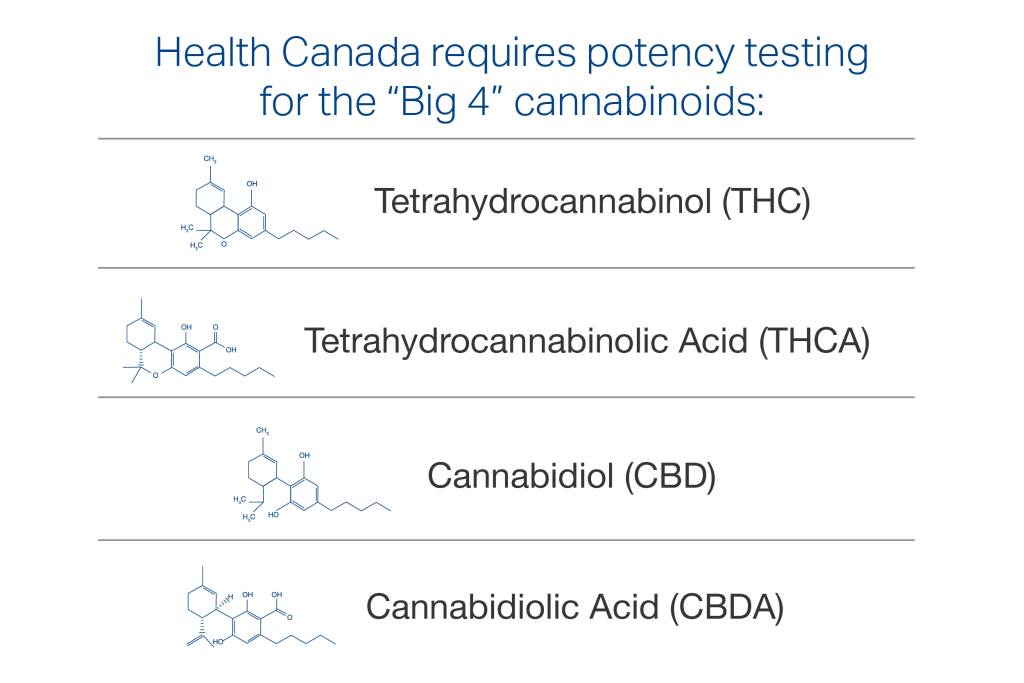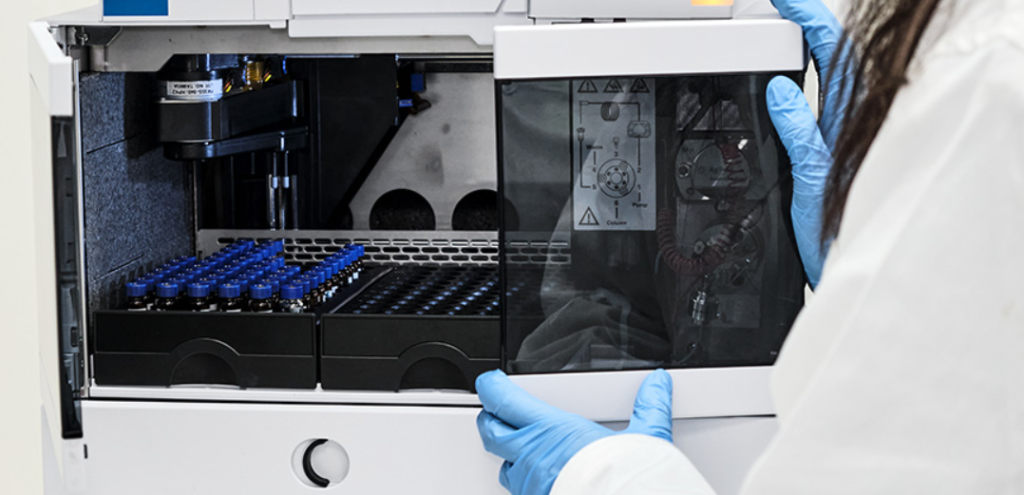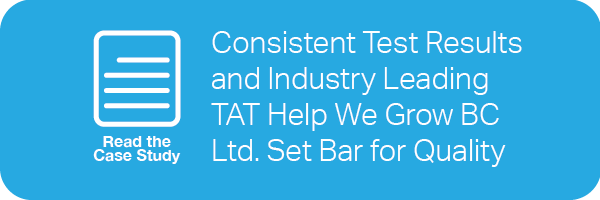Testing Cannabis Potency: An Industry Guide
Creating exceptional and safe products is the only way to make it in the cannabis industry. But what good is an outstanding product if you can’t prove that it’s genuinely exceptional or can’t get it to the market? Testing cannabis potency is one way to do both, and in this post, we explain how it’s done.
Why Testing Cannabis Potency is Vital to Your Business
Cannabis potency testing measures the cannabinoids in cannabis and the strength of those compounds. It’s one of the key product attributes that customers seek. Focusing on potency is also how some producers distinguish their products from the competition and sell them at a higher price point.
Under the Cannabis Act, each batch or lot of cannabis must be lab tested for…
- Tetrahydrocannabinol (THC)
- Tetrahydrocannabinolic acid (THCA)
- Cannabidiol (CBD)
- Cannabidiolic acid (CBDA)
See our post on tips for collecting samples when performing cannabis testing.
The seller must also report the total THC, CBD, and complete cannabinoid profile on the label.
How Total THC is Measured
THCA, or tetrahydrocannabinolic acid, is the inactive form of THC that is found in raw cannabis. It’s converted to the active delta-9-THC by losing its carboxyl group. This can happen through degradation over time or through heating.
Labs test for both cannabinoids independently and sum the percentage of THCA (accounting for the difference in weight of both molecules) to the available THC to get total THC content.
Health Canada Also Requires CBD Potency Testing
Cannabidiol and cannabidiolic acid potency tests are also required under the Cannabis Act. Cannabidiol (CBD) is the primary non-intoxicating cannabinoid in cannabis. It’s also the second most abundant cannabinoid in cannabis. Total CBD content also must be indicated on the product label.

What is the “Gold Standard” for Cannabis Potency Testing?
Currently, there is no gold standard for cannabis potency testing.
The cannabis industry is still emerging, and one of the consequences of its infancy is a lack of standardization for testing methodologies. While Health Canada requires a cannabis testing lab to validate its methods, it does not publish regulations regarding which methods to use, or which are “better” than any other.
It’s up to you and your laboratory partner to determine the right method for your products.

Three Common Methods for Testing Cannabis Potency
That being said, there are three common methods for testing cannabis potency:
- High-performance liquid chromatography (HPLC)
- Gas chromatography (GC)
- Liquid chromatography mass spectrometry (LC-MS)
High-performance liquid chromatography (HPLC) is the typical method many cannabis testing labs use, including Labstat.
HPLC can separately quantify THC, CBD, CBDA, and THCA without derivatization. Cannabis undergoing HPLC analysis is not heated, and it is possible to detect the THC and CBD precursors, THCA and CBDA.
How HPLC Works for Testing Cannabis
There are five basic steps when analyzing cannabis products using HPLC:
- Step 1: Thoroughly mix the sample of plant material or extracted oil in a solvent.
- Step 2: Fill the vials in the HPLC instrument with the mixture.
- Step 3: The HPLC instrument will inject the mixture into its column.
- Step 4: A solvent is added to the mixture as it passes through a filter media.
- Step 5: Each cannabinoid passes through the filter media at a different rate, allowing the detector in the HPLC instrument to measure its potency.
This information is displayed on the Certificate of Analysis the laboratory will provide to you.
LC-MS is Ideal for Analyzing Low THC Levels
Labstat also uses liquid chromatography mass spectrometry (LC-MS) for testing THC potency in some cannabis products, such as hemp-derived products and edibles. Health Canada requires THC percentage in edibles to be below 10 milligrams per container. LC-MS allows technicians to quantify low levels of THC to validate that the product meets regulatory requirements.
Using the Right Methods Requires Expertise
Gas chromatography uses derivatization to quantitate THC and CBD and their acid forms. However, derivatization methods are highly subject to error and difficult to validate.
Each method is best suited for different sample types. HPLC is best suited for liquid and edible products that are not reheated during consumption, but it can also be used for testing cannabis flower. Different tests can be coupled with other analytical techniques such as mass spectrometry.
The lack of regulations and other variables involved demonstrate the importance of working with a cannabis testing lab that has experience validating the appropriate test methods for your products.
Labstat has been testing cannabis products since the industry emerged, and we are happy to talk to you about your products and which tests might be needed.
What Additional Information Do Consumers Want About Your Cannabis Products?
Because Health Canada only requires you to test for total THC and CBD (the four cannabinoids), many producers focus solely on those cannabinoids. But research is uncovering the role minor cannabinoids play in the overall cannabis experience, and consumers are beginning to desire more information about your products.
Minor Cannabinoids May Affect Your Product Performance
Cannabinoids interact with endocannabinoid receptors in the body and brain differently, which influences whether the product is ideal for pain relief, mood regulation, or other benefits.
While THC and CBD are the most widely known and desirable cannabinoids, others are emerging as we learn more about them, such as cannabinol (CBN). For that reason, basic cannabis potency testing may not cut it anymore; a full cannabinoid analysis test helps you and your customers understand your products clearly.
This requires working with a lab partner with the equipment, expertise, and capacity to test for minor cannabinoids. Labstat cannabinoid potency analysis includes seven cannabinoids and three cannabinoid acids. We use validated methods to test potency for…
- Delta-9 THC
- Delta-8 THC
- CBD
- CBC
- THCV
- CBG
- THCA
- CBDA
- CBGA
- CBN
In addition, given our size and expertise, we have the ability to continually update and validate our methods to test for new and emerging cannabinoids, which smaller cannabis testing labs may not be able to do.

Consider These 4 Factors When Testing Your Product for Potency
1. Does The Lab Specialize in Testing Cannabis Potency & Do They Have Experience With Your Products?
Are you bringing a new product to market? Before choosing a cannabis testing lab, qualify its capabilities in your area of business and its experience analyzing your product type. Not every lab has the experience or instruments to test a full range of cannabis products for a full range of cannabinoids.
2. Does the Lab Use Validated Methods?
Health Canada adopted the regulatory requirements for method validation established by The International Conference on Harmonization (ICH).
Method validation is a process that demonstrates the suitability of an analytical method for an intended purpose. The requirements for method validation are…
- Accuracy
- Repeatability
- Precision
- Linearity
- Limit of quantitation and detection
- Range
- Specificity
- Robustness
Labstat uses validated methods that are suitable for a range of cannabis matrices, including flower, extract, topical, and edible.
3. Does the Lab Store Samples Properly?
How cannabis is stored matters. Proper storage ensures your product retains potency. It’s well documented that THC degrades into CBN over time if cannabis is stored at elevated temperatures or exposed to light.
Proper storage of the sample at the lab is necessary for accurate results in the final product.
4. Plan Ahead to Save Money
Many cannabis producers are strapped for time and money. You need potency testing early in your development process so you can have labels made and products shipped. But the challenges of running a successful business can make it tough to plan your testing ahead of time.
So, many producers end up paying rush charges to get potency testing results quickly. To avoid extra costs, plan your testing ahead of time so you get results when you need them minus the extra costs.
Labstat helps by delivering fast turnaround time for cannabis potency testing. We also offer cannabis testing packages (which you can see on our Sample Submission Form) to help you decide which tests to perform on your products to ensure you meet quality and regulatory requirements.
Potency Testing Helps Build Loyal Customers
Your customers want to purchase products with the CBD and THC percentages indicated on the label, and they want a consistent experience each time they buy your product. It’s well documented that some cannabis products don’t live up to their potency label claims.
Testing cannabis potency helps you deliver what your customers want, which will build loyalty and keep them coming back. To succeed, you need a consistent product and an experienced laboratory partner who offers accurate, timely, and comprehensive analytical data, in addition to guidance on compliance and regulatory needs.
Labstat uses validated test methods and offers industry leading experience in cannabis testing. We provide reliable and defensible data you can trust and regulatory consulting all in the same place.
Contact us today to find out how our cannabis testing services can help your business.

